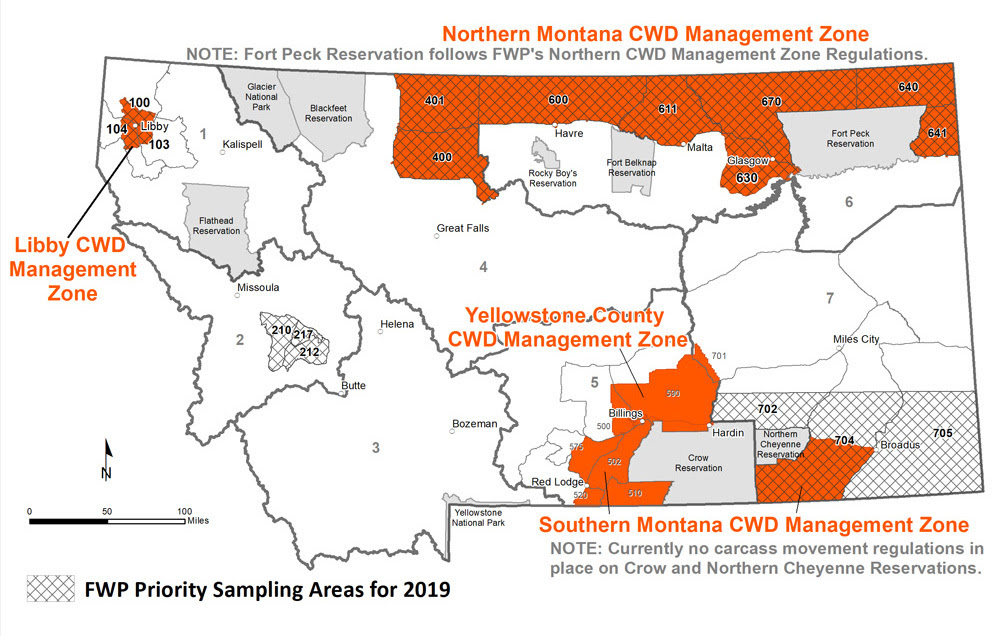News
Managing chronic wasting disease
Published
4 years agoon
Posted By
Outlaw Partners

Montana’s approach to a fatal wildlife infection
By Jessianne Castle EBS ENVIRONMENTAL & OUTDOORS
BOZEMAN – In mid-October, samples from a mule deer buck on Montana’s Hi-Line were packaged and shipped to Colorado. There, scientists at Colorado State University confirmed the news: the deer was infected with a fatal disease that has slowly cropped up in deer within the Treasure State. Another was confirmed on Nov. 4 in an area northeast of Joliet.
Known as chronic wasting disease, this infection has been confirmed in approximately 60 deer statewide since it was first found in wild herds in the Treasure State in 2017. It has been found along the Hi-Line mostly north of Highway 2; in southern Montana south of Billings; within a half-mile of the southeast border near Decker; and in the northwest near Libby.
CWD, making its way into newspaper headlines as “zombie deer disease,” is a difficult problem, one that wildlife disease ecologist Emily Almberg is increasingly faced with in her role at Montana Fish, Wildlife and Parks.
CWD is a slow-moving, fatal neurological disease that affects deer, elk and moose, though it has only been confirmed within Montana in our wild deer herds. It is caused by a misfolded protein known as a prion, and Almberg says once an animal is exposed to the prions, they accumulate in the nervous system and cause normal cellular proteins to misfold. This ultimately leads to tissue dysfunction and death. In advanced stages, there is so much damage to the brain that the organ comes to resemble Swiss cheese.
And the challenge for managers is multifaceted. For one, there is no known noninvasive method to sample for CWD; tissue samples from the nervous system or lymph nodes from a dead animal are required for testing. Additionally, CWD-causing prions are capable of surviving in the soil for what is yet unknown lengths of time and a sick deer can spread the disease even before the appearance of symptoms.
“If left unmanaged, CWD will spread,” said FWP Director Martha Williams in a statement. “As infection rates increase, it can have a significant impact on our wildlife.”
According to Almberg, herds heavily affected by CWD can see serious population declines—in Colorado, mule deer populations have dropped 45 percent over 20 years and in Wyoming, one herd is experiencing a 21-percent annual decline. Yet perhaps the most worrisome piece remains that researchers haven’t been able to find a cure.
CWD was first discovered in 1967 in mule deer at a Colorado research facility. It quickly showed up in captive mule deer and elk in Ontario, Colorado and Wyoming, and by the ’90s, it was present in wild deer, elk and moose in Colorado and Wyoming and in captive herds from Saskatchewan, South Dakota and Oklahoma, as well as at a game farm in Philipsburg, Montana. At the time, the infected Philipsburg elk were destroyed and the facility was quarantined.
As of 2017, CWD was present in wild cervid herds in 25 states, three Canadian provinces, Norway, Finland and South Korea. It reared its ugly head for the first time in Montana’s wild populations in October 2017 when a deer harvested south of Billings tested positive.
“I think probably CWD has been here for a while and we’re just finding it,” Almberg said, noting that as a slow-moving disease, it can take a while before it becomes detectable. Though animals that have reached the terminal stage are visibly sick—with excessive salivation, emaciation, apparent drowsiness and a lack of muscle coordination—it can take up to two years before symptoms develop.
Montana’s management of CWD continues to evolve as new cases appear. Guided in-part by a citizen advisory panel, FWP has designated CWD Management Zones where the disease is known to exist, and is also sampling high-risk areas in order to look for any new infections.
To prevent the spread of the disease, transport restriction zones have been set up across CWD Management Zones. Additionally, hunters can opt to have any deer tested for CWD and FWP will cover the costs and submit the samples for testing. While the disease is not thought to be transmissible to humans or domestic animals, the Centers for Disease Control and Prevention recommend sick animals should not be consumed.
Almberg said an important point for hunters to remember is to avoid inadvertently spreading the disease and that proper disposal is key. Rather than dump body parts or trimmings in ditches or carcass piles, she said hunters should leave the spinal column at the kill site and dispose of hides, bones and trimmings at approved landfills. Not only is it illegal to dump carcasses near roadways, but also if it is infected with CWD, the carcass can spread the disease for at least two years.
Visit fwp.mt.gov/cwd for more information.
The Outlaw Partners is a creative marketing, media and events company based in Big Sky, Montana.


Upcoming Events
april, 2024
Event Type :
All
All
Arts
Education
Music
Other
Sports
Event Details
Saturday, March 23rd 6:00-8:00pm We will combine the heart-opening powers of cacao with the transcendental powers of breathwork and sound. Together, these practices will give us the opportunity for a deep
more
Event Details
Saturday, March 23rd 6:00-8:00pm
Time
March 23 (Saturday) 6:00 pm - April 23 (Tuesday) 8:00 pm
Location
Santosha Wellness Center
169 Snowy Mountain Circle
Event Details
We all are familiar with using a limited palette, but do you use one? Do you know how to use a
more
Event Details
We all are familiar with using a limited palette, but do you use one? Do you know how to use a limited palette to create different color combinations? Are you tired of carrying around 15-20 different tubes when you paint plein air? Have you ever wanted to create a certain “mood” in a painting but failed? Do you create a lot of mud? Do you struggle to achieve color harmony? All these problems are addressed in John’s workbook in clear and concise language!
Based on the bestselling “Limited Palatte, Unlimited Color” workbook written by John Pototschnik, the workshop is run by Maggie Shane and Annie McCoy, accomplished landscape (acrylic) and plein air (oil) artists,exhibitors at the Big Sky Artists’ Studio & Gallery and members of the Big Sky Artists Collective.
Each student will receive a copy of “Limited Palette, Unlimited Color” to keep and take home to continue your limited palette journey. We will show you how to use the color wheel and mix your own clean mixtures to successfully create a mood for your paintings.
Each day, we will create a different limited palette color chart and paint a version of a simple landscape using John’s directives. You will then be able to go home and paint more schemes using the book for guidance.
Workshop is open to painters (oil or acrylic) of any level although students must have some basic knowledge of the medium he or she uses. Students will be provided the book ($92 value), color wheel, value scale and canvas papers to complete the daily exercises.
Sundays, April 14, 21 and 28, 2024
Noon until 6PM.
$170.
Time
14 (Sunday) 12:00 pm - 28 (Sunday) 6:00 pm
Event Details
Trivia from 7 to 9 p.m. at The Waypoint in Town Center. Participation is free, food and beverages available.
Event Details
Trivia from 7 to 9 p.m. at The Waypoint in Town Center. Participation is free, food and beverages available.
Time
(Wednesday) 7:00 pm - 9:00 pm
Location
The Waypoint
50 Ousel Falls Rd










